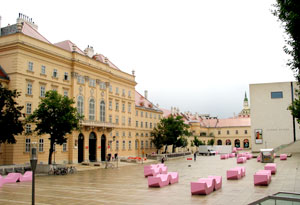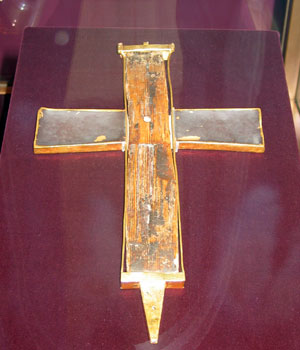VIENNA, AUSTRIA – Austria's glittering capital is a treasure chest of hidden historic gems - but, you may need some help finding them. Enter Hebe Jeffrey.
The Scottish music teacher who arrived in Vienna "over 20 years ago" to learn the German language and never left, is now a city guide who likes introducing visitors to places where those gems are kept.
The fast-walking woman, who has a passion for golf ("what do you expect? I'm Scottish") is one of the city's 600 or so registered guides who helps tourists not only find places of interest but also explain their significance.
(Experienced travellers usually hire guides to help introduce them to a city on the first day of a visit and then use that knowledge to make the rest of their stay a lot more enjoyable. It's money well spent - between $50 and $100 a day - because the guides give valuable tips, like where the best restaurants are located and how to use public transit, that will help save you money in the long run.)
Case in point: As we entered a wonderful square with the statue of one of Empress Maria Theresa's 16 children (Josef) riding a bronze steed, the faint sound of angelic voices could be heard coming from one of the statue-laden buildings in the cobblestone area. At first, the voices were so pure and the sound of such high quality we thought it was a recording.
"That's just a choir practicing before mass at St. Augustine Church," said Jeffrey as she pointed to a nondescript entrance off to the side.
"St. Augustine is where the royal weddings were once held and it contains a small but marvellous collection of art and statues.


Above: There's plenty of modern art in Vienna but the Treasury Museum, right, holds historic relics.
"You can attend mass or just visit during a service and get a free concert; works of Mozart, Schubert, Haydn and others are played there every Sunday," said Jeffrey as we sat for a few minutes and listened to the wonderful voices and music (performed by a small orchestra) coming from the huge choir loft.
Jeffrey then led us out of the church, cross the square and into "the best museum in all of Vienna." A pretty bold statement since Vienna appears to have the greatest collection of museums (over 160 and counting) this traveller has ever seen.
We danced between the raindrops (showers in Vienna appear suddenly) as we crossed the square, past a building Jeffrey said was the national library - "it contains over six million books" - and arrived at an entrance featuring an ornate steel door.
"This is the Schatzkammer (Treasury Museum)," said Jeffrey. "What you are about to see behind this door will simply amaze you."
For the next two hours or so, we were awed by treasures like:
- The Imperial Crown of the Holy Roman Empire and the equally ornate Crown of Emperor Rudolf II (the Habsburgerkrone), both featuring enough (uncut) jewels to keep Birks supplied for the next decade.
- A golden crib made for one of Napoleon's children.
- A piece of Christ's Cross, a small portion of His burial cloth and a golden goblet containing a tooth of John the Baptist.
- The chain of the Golden Fleece.
- Ancient mass robes dating back to 1400 in Burgundy and spun from gold and silver thread.
- A 2,680-carat emerald - the biggest in the world.
- A 4th-century agate bowl that is honoured as the Holy Grail.
One could have spent an entire day just marvelling at what was housed at the museum but Jeffrey, always aware that there were other amazing treasures to be discovered around the corner, encouraged us to move on. As we passed the Imperial Church opposite the treasury, our guide told us this was the place where the world famous Vienna Boys Choir performed every Sunday, "but you need to buy tickets for that performance."
We made our way to the No. 1 tram (the city's excellent trams and subways work on an honour system and cost about $2.50 per ride). Jeffrey told us the No. 1 and No. 2 trams take visitors around a series of streets that form the Ringstrasse and are the cheapest tourist tours one will ever enjoy.
"Vienna is a city made up of 23 districts, but the first and second districts are where you will find most of the historic sites," said Jeffrey, who pointed out that the city of 1.5 million has actually decreased from its 2.1 million population of 1910.
We hopped on the No. 1 tram in front of the People's Park, where a statue of Mozart stands - the bad boy of classical music lived here for 10 years and created some of his greatest works in a city still regarded as the music capital of the world - and began passing a collection of buildings that would all qualify for entrance into the architecture hall of fame.
Austria's beautiful parliament building, featuring columns and statues that make you feel as if you are touring Rome or Athens; the city's multi-spired Town Hall; classic Baroque buildings like the Karlskirche church and the Gothic Votivkirche church, which Archduke Ferdinand had built after an assassination attempt against him failed; and other massive buildings decorated with gilded statues and marbled columns and now used as museums and theatres, passed by as the slow-moving tram made its way around the Ringstrasse. On the opposite side of the Ringstrasse sat the People's Garden, where we later discovered a wonderful rose garden with dozens of varieties named after famous Austrians.
What was truly amazing about the collection of buildings around the Ringstrasse was that they were apparently all constructed in a 30-year period, according to our guide.
"This is our stop," said Jeffrey, a former student at the Royal Conservatory (in London) who specializes in music tours of Vienna.
We exited onto a street that contained more ornate buildings. But one stood out from all the rest.
"That is Vienna's opera house," said Jeffrey, pointing to a handsome building that looked very much like Paris' famed Opera Garnier. It was highlighted by statues of mounted riders, all former members of Austria's imperial families. Jeffrey told her captive audience that the opera house had, over the years, developed into one of "the top four in the world" but at first "was considered a disappointment by Emperor Franz Joseph." That criticism led to one of the buildings' two architects committing suicide and the other dying shortly thereafter of what many believed was a broken heart.
"After that," said Jeffrey, "the emperor never again criticized anyone in public."
We saw a group of young people lined up outside the opera house. Jeffrey told us they were there to purchase standing-room tickets for that night's performance of Carmen. Kids here attend the opera like Canadian kids attend hockey games.
Beside the opera house, in Ottahringer Square, is the Albertina art museum, a former palace that was the biggest within the inner city during Vienna's heyday. A short distance from the Albertina is the Gates of Violence, a striking monument dedicated to the victims of Nazi tyranny. It was built with stones from former concentration camps.
Jeffrey promised to introduce us to the places where Mozart lived during his 10-year stay in Vienna. She took us down small streets and alleys, pointing to buildings that few visitors would know was were where the gifted but troubled young composer (he died here at 35) stayed.
Along the way we passed more impressive buildings, like the wonderful Museum of Art History (every major painter is displayed here), a Gothic masterpiece called the Cathedral of St. Stephen (you could spend a day just touring this treasured building that contains the crypts of former imperial family members and one of the most unique pulpits in the world), the Museum of Natural History and the massive New Hofburg, the 18-wing, 2,600-room former Imperial Palace that is now home to museums and the famed Spanish Riding School.
Jeffrey also pointed out the three major pedestrian shopping streets - the Karntnerstrasse, Kohn Markt and Graden - where all the latest fashions can be purchased at upscale shops that sit beside Vienna's famous coffee houses, where hearty and reasonably priced meals can obtained. In fact, one of the surprising things about Vienna is just how affordable it is, much cheaper than either Paris or London, as a matter of fact.
We passed the Cafe Central - the pastries there were divine - and the Cafe Leopold Hawelka, the oldest restaurant in Vienna, where we suggested a sampling of their fine food might be in order, but Jeffrey informed us: "I'm taking you to the best schnitzel restaurant in Vienna for lunch. It's not far now."
Just behind St. Stephen's, Jeffrey led us down a narrow, hidden lane and into a courtyard.
"This area is called the Domgasse and No. 56 is the place where Mozart wrote Figaro," said Jeffrey.
A few minutes later, we were standing in front of No. 8 Schulerstrasse, another of Mozart's homes where he and his friends - people like Franz Joseph Haydn and Franz Schubert - liked to meet and play together. We took note of the quaint King of Hungary Hotel next door and decided it would be a nice place to stay on our next visit.
Finally, we arrived at the Figlmuller restaurant, a 100-year-old establishment that has become world famous for the size of its portions. Eyes bulged as golden schnitzels (breaded cutlets of pork or veal) the size of medium pizzas overflowed plates - and they were pretty big plates.
"I think I'll share a schnitzel," I told Jeffrey.
"Just too much for one person, right?" our wonderful guide said.
"This meal is just like Vienna," I told her.
"It's just too much to digest in one sitting."